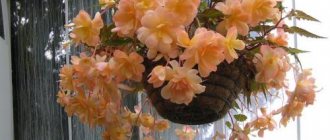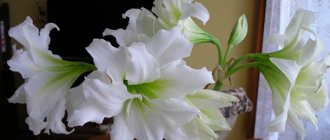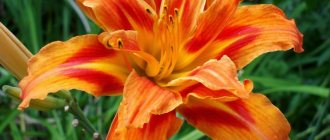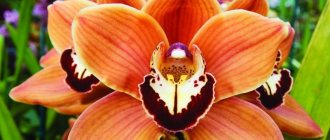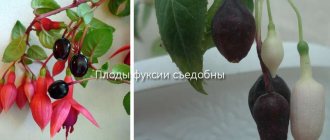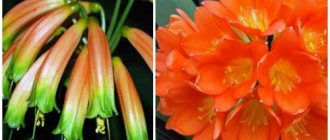Tritsirtis is an extremely popular representative of the lily family, which is of interest not only to flower growers, but also to gardeners. In the end, it is not for nothing that among professional cultivators this small genus received the name “Garden Lily.” This flower is native to the high peaks of the Japanese Islands and the Himalayas, but it is not only found there. The fact is that Tritsirtis began to be cultivated back in the eighteenth century, and therefore during this time it spread not only throughout Asia, but also beyond its borders.
Garden lily tricyrtis: description of the flower
Tritsirtis: flower photo
Speaking about the small number of this genus, it is worth noting that this issue has not yet been fully resolved. The fact is that how many species belong to the Tricyrtis genus is still the cause of heated debate and discussion in the community of professional breeders. However, if we calculate the arithmetic average, we can note that there are about fifteen species of Tricyrtis in total.
This plant also has several completely different names, each of which has incredibly interesting and unusual origins. As already mentioned, gardeners call this flower a garden lily, but its original name - Tritsirtis - comes from the Greek language and literally translates from it as “three tubercles”. This name comes from the fact that this flower has three nectaries.
An equally interesting name was given to Tritsirtis by the Filipinos, who call this exotic toad lily. The fact is that the juice of this plant attracts amphibians, which include toads, which, by the way, are a Philippine delicacy. Well, in order to catch these agile animals, the hunters lubricate their hands with the juice of Tritsirtis.
Spreading
Tricyrtis is one of the perennial ornamental plants from the large lily family. Distributed in the Far East and East Asia. The name translated from Greek means “three tubercles.”
Tritsirtis has another name - toad lily. This is explained by the fact that the natives of one Philippine island use the juice of the plant to attract edible frogs. They rub it on their skin, which makes catching much easier.
The Tricyrtis genus has about twenty species. Thanks to the original shape of the flower, Tricyrtis began to be called a garden orchid.
Features of the plant
Garden orchid ricirtis - like most orchids, is a perennial plant, and its root is very short, which makes this plant incredibly delicate and fragile. Most often, the stems of Tritsirtis grow absolutely perpendicular to the ground, but there are also branching varieties. The leaves of this genus are far from the most beautiful and attractive. They have the shape of an inverted egg. Sometimes very oblong leaf blades are also found. However, even the inconspicuous leaves of this genus of lilies have an interesting feature: they are colored almost exactly the same as the petals, with the exception of bright and variegated colors, of course. However, they are covered with the same spots and patterns as Tricyrtis buds.
By the way, speaking of buds. They always have no more and no less than six petals, and, of course, a lip. Most often, the buds are completely painted white, on top of which you can find specks of completely different shades. However, most often the patterns on the petals of a flower have shades close to red: burgundy, purple, pink, and so on.
Most often, the flowers do not form inflorescences and grow exclusively solitary, but you can also find those varieties that collect buds in umbrella inflorescences. As already mentioned, each bud also has three nectaries, and, of course, a lip, which in this genus is very modified and is not always easy to detect.
In addition, this oridea, even at home, may well ripen fruits that look like small boxes containing seeds that can be used for propagation.
Tritsirtis: flower photo
Tritsirtis: planting in open ground
This question is incredibly important and relevant, since most often Tritsirtis is planted in open ground gardens, and not at all in pots.
In order to do this correctly and provide the orchid with the best conditions in which it will delight you with the best flowering, you should carefully follow all the points of the instructions below:
When to plant?
Tricyrtis seeds are planted in open soil immediately after they are collected. Most often, this period occurs with the onset of cold weather, but do not be afraid that the seedlings will not survive the coming frosts and will simply die in the ground. The likelihood of this actually happening is extremely low.
However, it may also happen that planting before the onset of winter will simply be impossible and will have to be postponed until spring. Of course, the percentage of germination will not be nearly as significant as when planting seeds immediately after collecting them, but with careful stratification, spring planting can also be quite successful. However, for this you will have to choose the timing very carefully, because stratification takes almost two months, and you must be completely sure that by the time it is completed, all return frosts will have passed.
By the way, it is possible to propagate the garden orchid tricirtis using other, non-seed methods, but we will talk about them later.
Rules for planting tricirtis in open ground
First of all, of course, you will need to choose a site suitable for Tritsirtis, where he will feel most comfortable. The best place for this is some shaded place, for example, under the roof of a gazebo or under the canopy of a tree.
As for the soil, then, of course, there are also certain requirements for it. First of all, it must be loose and have the same composition as forest soil. This means that it must contain a sufficient amount of peat and humus. Another option is to grow Tritsirtis in black soil, but even in this case you will have to add peat to the soil.
Speaking about the illumination of the area, although Tritsirtis should be in the shade, this does not mean that it should be deprived of light at all. However, the most important thing is not the brightness, but the regularity of sunbathing, and therefore you must make sure that Tritsirtis was under diffused light for at least half of the day.
Completely different rules, however, work for late varieties of this plant, since they need a lot of light and it must be very constant and regular. The fact is that twilight in autumn comes much later than in spring or summer, and therefore the flower may simply not have enough light to form buds and inflorescences.
It is also important to provide protection from through winds. In principle, Tricyrtis are completely independent of ventilation, and therefore you should not have any difficulties with the wind: you can completely exclude it from the life of the flower.
But what you need to pay very close attention to is moisture stagnation. It has an incredibly detrimental effect on this genus with a very delicate root system. However, perhaps the same can be said about any other orchid.
When planting seeds, you must also remember that they must be buried. However, the recess should not be deep at all: no more than a third of a centimeter. Also, after planting, it is mandatory to thoroughly moisten the soil with the seedlings. The only drawback to growing Tritsirtis from seeds is that it will bloom only after two or even three years.
Tricyrtis seeds: photo
Creating conditions for growing
To successfully breed tricirtis, you should create the most favorable conditions for growth:
- Air temperature and humidity. For tricirtis, the optimal temperature is in the range of 15-20 degrees. But this is not a necessary condition and the toad lily will grow at higher temperatures. It is more important to maintain a high level of humidity - not lower than 85%.
- Landing place. A place protected from the winds with diffused light should be allocated. Direct sunlight has a detrimental effect on the plant, but morning and evening sun is harmless. With strong shading, flowers can become faded and inconspicuous.
- Soil composition. Tricyrtis are demanding on the soil. It should be fertile and generously seasoned with humus and peat. To achieve the desired level of acidity, lime must be added to the soil. Flowers prefer loose fertile black soil. Toad lilies will not grow in soil with a high clay content, which tends to dry out and harden quickly.
- Also, water should not stagnate in the soil, so you should worry about quality drainage in advance. The degree of soil moisture should be average and mulching will help with this, as it retains moisture longer.
The best time for planting is spring, but planting can also be done in September. Young plants will not bloom in the year of planting.
Tritsirtis: caring for a flower in the open ground
Caring for a garden orchid tricyrtis is exactly what you would expect from caring for an orchid: it is far from the simplest process, with a huge number of small details and nuances. But, nevertheless, it is still much simpler than growing domestic species of orchids, and therefore, with the proper desire, responsibility and care, even an amateur gardener or a complete novice can cope with it.
You can avoid most of the problems already at the planting stage, since it also implies a large number of rules, following which you can easily make the flower’s life easier. Well, further care and cultivation of Tritsirtis involves very careful adherence to the watering and feeding regime, which certainly should not cause you any difficulties. As a matter of fact, we will begin our instructions with watering and fertilization:
How to water and feed Tricyrtis
On many websites and gardening guides you will be able to read about Tricyrtis that it is an incredibly drought-resistant crop. It is, of course, impossible to say that this is true, however, on the other hand, a person can easily survive by eating only once a day. However, you can probably imagine how bad this will make you feel.
This also applies to plants, and therefore you need to water Tricyrtis quite often, no matter how its resistance to drought tries to confuse you. In addition to the fact that watering should be plentiful, it is very important to ensure that it is constant.
Water must also meet certain requirements. First of all, it should be soft enough, as hard water can harm the delicate roots of the plant. In addition, a very good solution would be to use rain or settled water, as it will be much more beneficial for the flower.
It is also necessary to observe watering techniques. You have probably already memorized that Tritsirtis has a delicate root system, and therefore watering should be careful and gentle. It will also be useful to slightly loosen the soil after each watering.
An equally important procedure is mulching the area, which many inexperienced gardeners, unfortunately, neglect. Of course, mulching is not something mandatory, but it greatly helps in growing absolutely any ornamental crop. Firstly, mulch prevents moisture from evaporating from the soil untimely. Secondly, it is a natural and very reliable protection against all kinds of weeds.
As for fertilizing, it is not a very necessary procedure, just like mulching. However, if you want the flowers of your Tricyrtis to be bright and the leaves to be healthy, then it is still better to use fertilizers. By the way, all kinds of organic fertilizers, such as humus, are perfect for this. However, mineral complexes may also be beneficial for Tricyrtis.
Tritsirtis: photo of a garden orchid
Care
This is not a capricious plant at all - tricyrtis. Planting and care are not difficult. Like any plant, tricirtis needs watering. But you need to know that the water should always be warm. It is better to use a drip irrigation system.
Do not allow water to stagnate. Otherwise, the roots may rot. Tritsirtis can overwinter in a flowerbed, but to do this it must be covered with special material. Peat or agrofibre are most suitable for this purpose.
Young shoots do not like high temperatures, so in early spring, as soon as it gets warm, you should get rid of the insulation. At the same time, fertilize with fertilizers - humus or compost. Then it is necessary to mulch with pine bark - it will prevent the soil from overheating. If you carry out all the work in a timely manner, then in July-August you will admire the flowering of this luxurious plant.
Flower transplant
Some may be pleased to hear that there is virtually no need to replant Tricyrtis. This plant exists very well in the very place where it was planted for the first time, but if it is regularly fed and well watered, you can completely forget about replanting.
However, the gardener himself may have a desire to replant the plant if, for example, the place where the flower grows is better given to some other crop. In this case, you will need, as with seed propagation, to select the most suitable site for Tritsirtis and prepare everything necessary, which will help the plant quickly and easily take root in a completely new and unfamiliar place.
Landing
If you have already decided which type of plant you like best, think about where your tricirtis will grow. Planting and care are not particularly difficult, but certain rules must be followed.
The plant develops well in a place protected from drafts and without stagnant water. Particular attention should be paid to the roots - they should not be overdried. The landing site should be well lit for half a day. It doesn't matter whether it's in the first half of the day or in the second. Black soil is most suitable for the plant. The soil should be loose and fertile.
Reproduction
There are several ways to propagate Tricyrtis, one of which you have already read in detail and which you have thoroughly learned. I am, of course, talking about the propagation method using seeds.
However, many gardeners do not like it, because, you see, propagation by seeds is an incredibly long process, and it is not at all common for people to like to wait. Therefore, the division method, which is carried out during forced plant transplantation, is no less popular. To carry out such a procedure, you will first of all need a sharp, well-sharpened tool. Once you have prepared it, you can dig up Tricyrtis. It is imperative to remove adhered lumps of soil from its root, as they can seriously interfere with the procedure.
Now that both the tool and the bush are ready, the root will split either in half or into more parts, depending on how large the root system of the mother plant is, and, of course, on how many new individuals you want to grow. When you are finished, the cut areas on the mother plant must be disinfected, as otherwise infection with bacteria and viruses is possible. In addition, remember that each plot must be very well cared for.
Wintering of Tritsirtis
Tritsirtis: photo of the plant
It is very important to understand that this tricirtis is not winter-hardy, despite the fact that it grows on the slopes of high mountains, and therefore, especially in our harsh winters, it simply vitally needs protection. There are several ways to ensure this. The first is covering the bushes themselves with a thick layer of peat, which will certainly not allow frost to destroy your Tricyrtis. Another way is to cover the bushes with agrofibre, however, to be honest, we would still prefer peat protection.
It’s a completely different question if you live in southern latitudes. There the climate is far from being so harsh, and therefore such serious protection from frost can only harm the flower. To avoid this, it is enough to limit yourself to just covering with ordinary film, and if the winter is going to be warm, then you can completely abandon the protection. However, despite the fact that the plant will not suffer much from this, experienced gardeners still do not recommend leaving a garden orchid without any protection, since an unexpected snowfall can simply kill a budding bush.
Pests and diseases
What Tritsirtis certainly cannot be blamed for is poor immunity. The disease resistance of this orchid is simply excellent, and therefore, if you properly care for the flower and do not make gross mistakes, there is definitely no need to be afraid of the sudden appearance of some kind of rot.
Nevertheless, such troubles as rotting of roots quite often happen to representatives of the Tricyrtis genus, but not because a fungus suddenly penetrated into them, but due to simple carelessness of the owner. That is why we have insisted and will not tire of repeating that watering is the most basic, but at the same time, the most important procedure, in which it is simply unacceptable to make mistakes.
Therefore, if you do not want to one day see your flower drooping and withering, be sure to try to consult with a more experienced gardener than yourself, since only a good specialist will be able to tell which watering regime will be good specifically for this species and specifically for this variety.
The situation is completely different with insects, since they, in fact, do not care how good the plant’s immune system is. It won’t hurt them to eat it anyway. Therefore, the best way to combat pests such as slugs, snails or spider mites is prevention. However, if it did not help and the parasites still reached your Tricyrtis, the only thing you can do is to personally collect them and take them as far as possible.
However, this applies to snails. What to do with spider mites? The method of combating them is even simpler and is called insecticides. Although many gardeners have a very bad attitude towards any kind of chemicals, unfortunately, it is very unlikely that you will be able to cope with the scourge of cobwebs in any other way.
The most popular varieties and types
Tricytis: flower photo
Of course, despite the fact that there are no more than fifteen species in the genus, breeders have long been working on various hybrid varieties, the number of which is currently simply enormous. Therefore, choosing exactly the Tritsirtis that you like is far from an easy task. However, this is why this list exists: we will present the best varieties and types of this unusual orchid, among which, we hope, you will definitely be able to find your ideal.
Taiwanese Tricyrtis (Tricyrtis formosana), or Formosan Tricyrtis
Of course, it was not for nothing that we mentioned this species first. The fact is that it is incredibly popular not only among gardeners, but also among gardeners who are not averse to caring for flowers that can easily decorate their property.
One of the main distinguishing features of this species is its record size. The length of its stems is practically never less than eight tenths of a meter, and the stems themselves are very pleasant to the touch, as they are covered with soft fibers.
The leaves of this species are no less attractive. They have an almost glossy surface, and their color is very bright and rich.
However, of course, the crown of this species is not the leaves or stems, but the stunning buds, which are painted white and covered with small purple spots. Their special decoration is the lip, which looks like an oblong pod, divided into three parts at the end. It is painted in a burgundy shade. By the way, you can also see pink spots on it.
Tricyrtis yellow (Tricyrtis flava = Tricyrtis yatabeana)
Already from the name you can easily understand how exactly this species differs from many other representatives of this small genus. Its homeland is the mountain thickets and forests of the Japanese islands, however, this flower takes root well here too.
Its buds are completely yellow and only rarely can small brownish-orange spots be seen on the surface of the petals or lips. Speaking of petals. Unlike most Tricyrtis, Tricyrtis yellow has fairly wide petals, which makes it look like an ordinary wildflower. However, its buzz immediately reveals that this species belongs to the orchid family.
As for the stem, it is nothing unusual. It reaches about half a meter in length, but there are also dwarf varieties that do not exceed a quarter of a meter in height.
Perhaps this was influenced by the unimpressive size of the flower, or perhaps by its simple coloring, but now Tricyrtis yellow is difficult to find in anyone’s garden. Nevertheless, in our opinion, he is more than worthy of taking pride of place there.
Tricyrtis hairy (Tricyrtis pilosa = Tricyrtis maculata = Tricyrtis elegance)
As soon as you look at the flower of this Tricyrtis species, you will immediately notice how unusual and unique it is. In fact, it is completely unlike any other flowers, and it may even seem that it came from another planet.
First of all, this impression of this flower is determined by its extraordinary color. First of all, it affects the stem, which is not only covered with thin hairs, as can be seen from the name, but may also appear blue to an observer from the outside.
The bud itself, however, is no less unusual than the stem on which it grows. It is painted white, but the spots on its surface are extremely unusual. Their edges are painted a rather dark and rich pink color, but the closer to the center, the brighter and paler the color becomes.
The alien look of the flower is complemented by the lip, which is completely green. At its base, however, you can find small white and purple spots, and at its tip there are three nectaries, which, by the way, appear long before the rest of the flower blooms.
Tricyrtis macropoda
Despite its name, this representative of the Tritsirtis genus still could not become longer than the very first representative of our list. The length of its stem reaches seven tenths of a meter, but there are also smaller specimens whose stem length does not exceed half a meter.
Speaking of color, the stem of this species is distinguished by the fact that it is very dark and, moreover, smooth. Against the background of bright yellow buds, this brownish-burgundy color looks very harmonious and stylish.
By the way, about the buds. They, like those of the Tritsirtis representative, whom we described just above, are almost completely colored yellow. However, this time the shade is much brighter and the number of brownish specks is much greater. In addition, the lip of the buds of this species is longer and more elegant, and it is crowned with nectaries, painted in an almost snow-white color.
Tricyrtis latifolia = Tricyrtis bakeri
Looking at this plant for the first time, it is difficult to even imagine that it is an orchid. The species is indeed very unique and significantly different from many of its relatives. The length of the siebli of this Tritsirtis reaches about six tenths of a meter, and along their entire length the leaves grow, which, as the name suggests, are very large, thanks to which the plantings of this Tritsirtis are very similar to real thickets.
A distinctive feature of this species is that it blooms very early, and therefore is ideal for creating flower arrangements that will delight the gardener from May to October.
However, why did we say that this species is so different from all other Tricyrtis? The fact is that its flowers are collected in very dense bunched inflorescences, which are very rare in the orchid family. The flowers themselves are painted creamy yellow and there are practically no spots on their surface.
Winter-hardy species
As already mentioned, Tricyrtis has quite a few species. Care and planting largely depend on what type you are getting - winter-hardy or not. Most species cannot withstand even mild frosts. The hardiest winter-hardy variety is Tricyrtis shorthaired. Japan is considered its homeland. Its bushes grow more than a meter in length, the leaves are oval, broadly lanceolate, more than 15 cm long, and have specks. Blooms in August. The flower is white and pink with purple spots.
Broadleaf Tricyrtis is native to China. It also belongs to winter-hardy varieties. The height of this plant is 60 cm, its leaves are oblong, covered with dark spots. Flowering begins in July, when white-green spotted flowers appear, located at the top of the stem and collected in a bunch.
